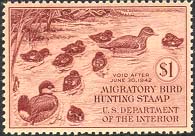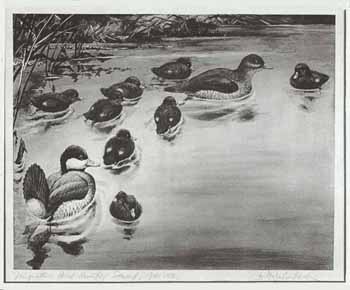

Back to RW8 Back to the Federal Index Home
A LITTLE HISTORY ON THE 8TH (1941-42) DUCK STAMP ARTIST


When Edwin R. Kalmbach chose the Ruddy Duck for his Duck Stamp, he had more than just aesthetic appreciation in mind. He decided on the Ruddy Duck because it is the only North American species in which the drake commonly stays with the female and ducklings during their downy young period. He felt the brood was the most appropriate one to feature because it represented the purpose for which Duck Stamp funds are used: the perpetuation and enhancement of the species. Dr. Kalmbach's choice showed not only his deep commitment to the fish and wildlife Service, but a keen knowledge that came from his background as a wildlife biologist.
He was born in Grand rapids, Michigan on April 29, 1884. He married in 1908 and had three children. From 1903 to 1910, Dr. Kalmbach served in his first job as assistant director of the Kent Science Museum.
He joined the biological Survey, U.S. Department of Agriculture, the forerunner of the Fish and Wildlife Service, as a biologist in July, 1910. His work in the department involved him in a wide variety of projects. At first, his job consisted of making field studies and authoritative reports on the Crow, Blackbird, House Sparrow, Starling, Magpie and other wildlife.
In 1928, he was assigned to deal with a serious and baffling wildlife problem concerning a devastating malady of western waterfowl. His research soon led to the discovery of avian botulism. This discovery, together with other findings, formed the basis of a campaign against duck sickness.
Soon after his retirement from the Fish and Wildlife Service in 1954, he received the honorary degree, Doctor of Science, from the University of Colorado in recognition of his outstanding record in research biology He also was the recipient of the highest honor the Department of the Interior can bestow: The Distinguished Service Award.
Dr. Kalmbach also received the Leopold Medal, presented to him by the Wildlife Society at the annual meeting in St. Louis in 1958. He was recognized for outstanding work in the fields of conservation and wildlife management. The Leopold Medal was one of the most coveted awards in wildlife conservation and had been given to only one other Duck Stamp artist, J.N. Darling.
Dr. Kalmbach held memberships in the Ornithologists Union, Wilson Society of Ornithologists, American Society of Mammalogists, and the Cooper Ornithologists Society.
Dr. Kalmbach died in Denver in August 1972.
---------------THE ART---------------
Ruddy Ducks was painted in watercolor wash using some gouache. The print was pulled from a stone lithograph using black ink on white paper. It was reprinted in a second edition as a fine grained gravure. The prints were signed in pencil but not numbered. the image of the lithograph is 6 1/2"x8 3/4". The image on the gravure is 7"x9".
---------------THE STAMP---------------
Ruddy ducks...Engraved by the Federal Bureau of Engraving from the original artwork. Printed in brown carmine ink. The stamp sold for one dollar. Postal records show 1,439,967 stamps sold. First day of sale was July 1, 1941.
Most of the information contained above is from the book Federal Duck Stamp Story, Fifty Years of Excellence, by Laurence F. Jonson; Alexander & Co. It is used here with permission from the author. For more information on this book, please click here.